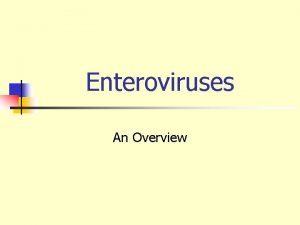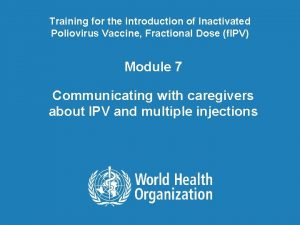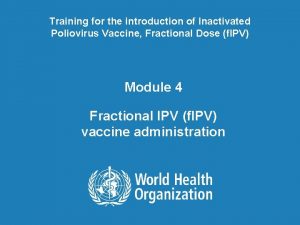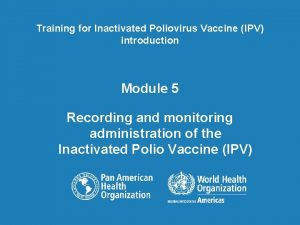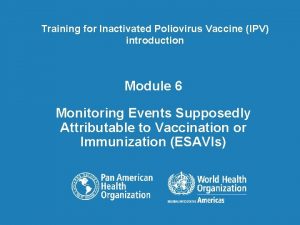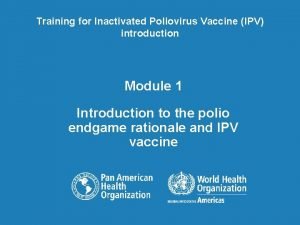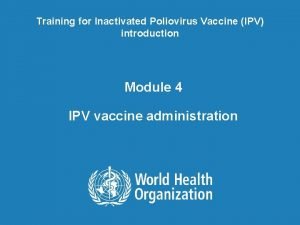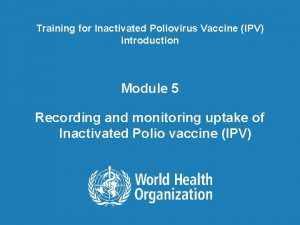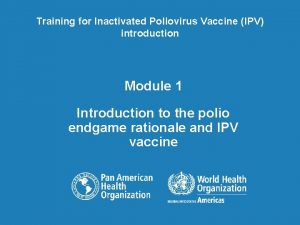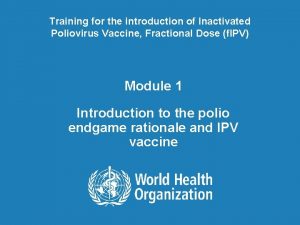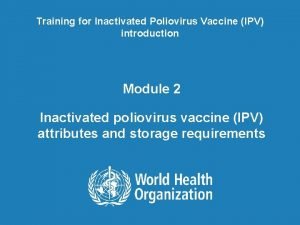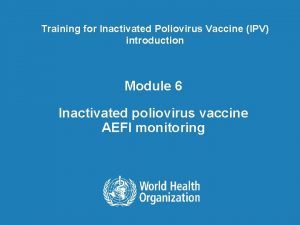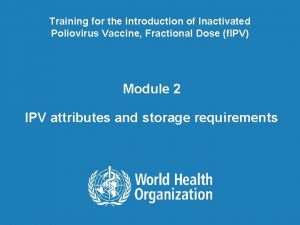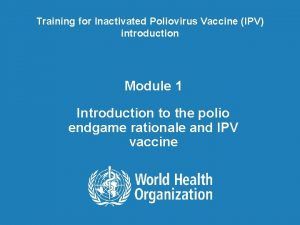Training for the introduction of Inactivated Poliovirus Vaccine
















- Slides: 16

Training for the introduction of Inactivated Poliovirus Vaccine, Fractional Dose (f. IPV) Module 1 Introduction to the polio endgame rationale and IPV vaccine

Learning objectives l At the end of the module, the participant will be able to: – Understand poliovirus transmission, poliomyelitis disease and global progress toward polio eradication – Recognize the vaccines available against polio and the risks and benefits of each – Describe the rationale for introducing IPV into the routine immunization schedule l Duration – 20 minutes 2| Introduction to polio endgame rationale and IPV, Module 1 | 29 October 2020

Key issues 3| Introduction to polio endgame rationale and IPV, Module 1 | 29 October 2020

What is polio disease? l Polio (also called Poliomyelitis) is a highly infectious disease caused by a virus l The virus invades the nervous system and can cause permanent paralysis l Polio is spread through person-to-person contact and can spread rapidly through a community l Most infected people (90%) have no symptoms or very mild symptoms l However, one in 200 infections leads to permanent paralysis (can’t move parts of the body) and even death 4| Introduction to polio endgame rationale and IPV, Module 1 | 29 October 2020 www. immune. org. nz

How does poliovirus spread? l Poliovirus infection is highly contagious l Poliovirus is spread mostly by the fecal-oral route – Primary mode of transmission – passage of the virus in stool to the mouth of another child – Can also be spread through saliva or droplets from a sneeze or cough Child excretes virus in stool 5| Virus transferred to objects from hands Virus transferred to another child’s hands Introduction to polio endgame rationale and IPV, Module 1 | 29 October 2020 Virus transferred ingested Next cycle of infection

How many polio cases are there? 1988 • • • 350, 000 cases 125 endemic countries World Health Assembly resolved to eradicate polio 6| Introduction to polio endgame rationale and IPV, Module 1 | 29 October 2020 2015 • • 74 WPV cases 2 endemic countries

Types of polioviruses l Wild poliovirus (WPV) – 3 serotypes – Type 1 – 74 cases in 2015 (this is the only type of WPV in circulation today) – Type 2 – officially certified as eradicated in September 2015 – Type 3 – last case reported in 2012 (more time is needed to certify eradication) 7| Introduction to polio endgame rationale and IPV, Module 1 | 29 October 2020

Types of Oral Polio Vaccines l 3 Types of Oral Polio vaccine – Trivalent OPV (t. OPV): types 1, 2 and 3 • Removed from ALL routine immunization globally in April 2016 – Bivalent OPV (b. OPV): types 1 and 3 • Now the most commonly used OPV in routine immunization globally – Monovalent OPV (m. OPV): type 1, 2 or 3 • primarily used for SIAs in areas where only type 1 or type 3 is circulating or in outbreak response OPV is still the primary vaccine required to achieve eradication 8| Introduction to polio endgame rationale and IPV, Module 1 | 29 October 2020

Paralysis associated with OPV l OPV offers effective protection against polio, but… l In very rare cases it can lead to paralysis – Vaccine Associated Paralytic Polio (VAPP) • Vaccine virus spontaneously changes and becomes capable of causing disease to the nervous system • 1 case per 2. 4 million vaccine doses administered • 250 -500 cases/year • Approximately 40% of VAPP are caused by type 2 OPV – Circulating Vaccine Derived Poliovirus (c. VDPV) • Rare outbreaks caused by person-to-person spread of vaccine strain, which mutates/changes to a highly transmissible form capable of causing disease to the nervous system, in areas/countries with low immunity against polio • Over 90% of c. VDPVs are caused type 2 OPV • Low coverage is one of the main factors for the occurrence of c. VDPVs 9| Introduction to polio endgame rationale and IPV, Module 1 | 29 October 2020

Polio eradication plan l In May 2012 the World Health Assembly of WHO declared poliovirus eradication to be a global public health emergency l Under this plan to achieve a polio-free world, they recommend that the use of OPV must eventually be stopped worldwide l Type 2 OPV has the two risks: VAPP and c. VDPV – and is no longer needed for eradication – hence the type 2 containing OPV has now been withdrawn from use l Once wild polioviruses 1 and 3 are eliminated, OPV will be withdrawn completely 10 | Introduction to polio endgame rationale and IPV, Module 1 | 29 October 2020

Polio eradication plan (continued) l WHO’s Strategic Advisory Group of Experts (SAGE) recommended in October 2014 that all countries introduce at least one dose of IPV into their routine immunization schedule l Rationale for this includes: – To reduce risks of an outbreak after type 2 OPV vaccine withdrawal – To help stop outbreaks quickly if type 2 virus is reintroduced – To boost immunity against polio types 1 & 3 to protect populations and hasten eradication 11 | Introduction to polio endgame rationale and IPV, Module 1 | 29 October 2020

Comparison of OPV and IPV? Oral polio vaccine (OPV) Inactivated polio vaccine (IPV) • Live, attenuated (weakened) virus • Administered by drops • Killed virus • Administered by injection • Highly successful in reducing transmission in developing countries as part of eradication strategy • Inexpensive • Easy to administer • Provides mucosal/gut immunity • Protects close contacts who are unvaccinated • Highly effective • Used commonly in developed countries 12 | • • More expensive than OPV Requires trained health workers Provides immunity through blood Carries no risk of VAPP or VDPV Introduction to polio endgame rationale and IPV, Module 1 | 29 October 2020 Both vaccines are needed to fully eradicate polio!

Why IPV? l IPV does not cause any paralysis and is a very safe vaccine l IPV introduction sets the stage for ending OPV use entirely after WPV eradication has been achieved l When use of OPV is eventually stopped, IPV will continue to provide full protection l Introducing IPV to our community also helps us remind caretakers about the importance of vaccinations overall, inform them about missed and upcoming vaccinations. 13 | Introduction to polio endgame rationale and IPV, Module 1 | 29 October 2020

Key Messages l Polio is a highly contagious viral disease that can spread rapidly through person-to-person contact causing permanent paralysis l There are 3 types of wild poliovirus but only type 1 remains in circulation today – Type 2 was officially certified as eradicated in 2015, and type 3 has not been since 2012 l OPV is inexpensive and effective at reducing polio transmission in developing countries, but carries a risk of VAPP and VDPV l All use of OPV must stop for the world to be completely polio-free l IPV is being introduced to provide protection against all 3 serotypes, while OPV is being phased out, to help us make the world polio free 14 | Introduction to polio endgame rationale and IPV, Module 1 | 29 October 2020

Inactivated Polio Vaccine (IPV) l Our country is about to introduce IPV l Next modules of this training will explain how to: ü Store the vaccine ü Determine vaccine eligibility ü Administer the vaccine ü Record the vaccine dose ü Monitor adverse events following immunization (AEFIs) ü Communicate with caregivers about the vaccine 15 | Introduction to polio endgame rationale and IPV, Module 1 | 29 October 2020

End of module Thank you for your attention! 16 | Introduction to polio endgame rationale and IPV, Module 1 | 29 October 2020
 Poliovirus lab diagnosis
Poliovirus lab diagnosis Poliovirus hominis
Poliovirus hominis Poliovirus structure
Poliovirus structure Kontinuitetshantering i praktiken
Kontinuitetshantering i praktiken Novell typiska drag
Novell typiska drag Tack för att ni lyssnade bild
Tack för att ni lyssnade bild Returpilarna
Returpilarna Varför kallas perioden 1918-1939 för mellankrigstiden?
Varför kallas perioden 1918-1939 för mellankrigstiden? En lathund för arbete med kontinuitetshantering
En lathund för arbete med kontinuitetshantering Underlag för särskild löneskatt på pensionskostnader
Underlag för särskild löneskatt på pensionskostnader Tidbok för yrkesförare
Tidbok för yrkesförare Sura för anatom
Sura för anatom Densitet vatten
Densitet vatten Datorkunskap för nybörjare
Datorkunskap för nybörjare Stig kerman
Stig kerman Debatt artikel mall
Debatt artikel mall Magnetsjukhus
Magnetsjukhus
